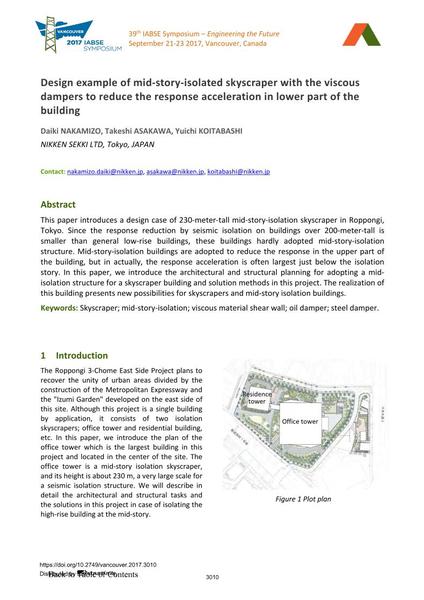Design example of mid-story-isolated skyscraper with the viscous dampers to reduce the response acceleration in lower part of the building

|
|
|||||||||||
Bibliographic Details
| Author(s): |
Daiki Nakamizo
(NIKKEN SEKKI LTD, Tokyo, JAPAN)
Takeshi Asakawa (NIKKEN SEKKI LTD, Tokyo, JAPAN) Yuichi Koitabashi (NIKKEN SEKKI LTD, Tokyo, JAPAN) |
||||
|---|---|---|---|---|---|
| Medium: | conference paper | ||||
| Language(s): | English | ||||
| Conference: | IABSE Symposium: Engineering the Future, Vancouver, Canada, 21-23 September 2017 | ||||
| Published in: | IABSE Symposium Vancouver 2017 | ||||
|
|||||
| Page(s): | 3010-3017 | ||||
| Total no. of pages: | 8 | ||||
| Year: | 2017 | ||||
| DOI: | 10.2749/vancouver.2017.3010 | ||||
| Abstract: |
This paper introduces a design case of 230-meter-tall mid-story-isolation skyscraper in Roppongi, Tokyo. Since the response reduction by seismic isolation on buildings over 200-meter-tall is smaller than general low-rise buildings, these buildings hardly adopted mid-story-isolation structure. Mid-story-isolation buildings are adopted to reduce the response in the upper part of the building, but in actually, the response acceleration is often largest just below the isolation story. In this paper, we introduce the architectural and structural planning for adopting a mid- isolation structure for a skyscraper building and solution methods in this project. The realization of this building presents new possibilities for skyscrapers and mid-story isolation buildings. |
||||
| Keywords: |
skyscraper steel damper mid-story-isolation viscous material shear wall oil damper
|
||||
